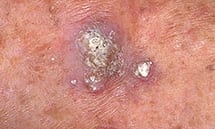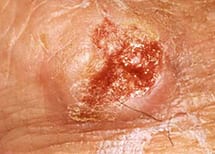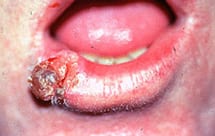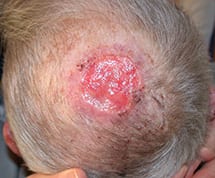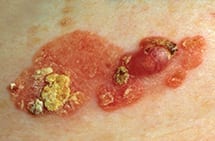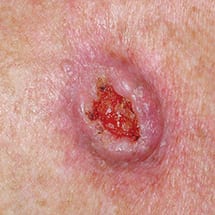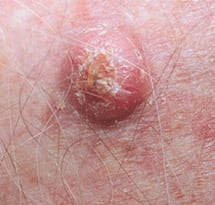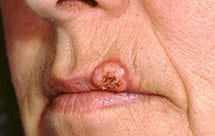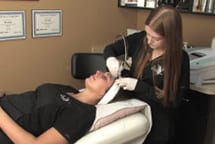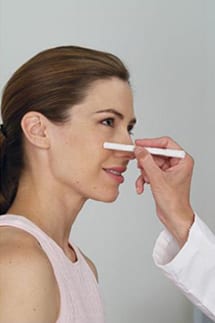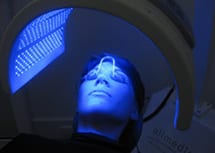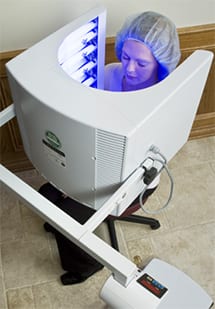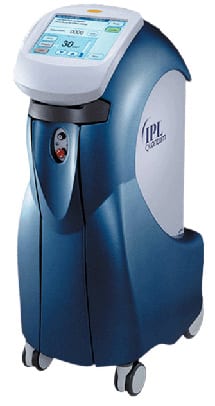Squamous Cell Carcinoma (SCC)
Serving Hamilton, Stoney Creek, Grimsby and surrounding areas
Squamous Cell Carcinoma (SCC):
- Is often a rough, skin coloured, or pink bump
- May sometimes ulcerate or bleed
- Is a skin cancer of intermediate severity
- May be as small as a 2 to 3 mm and as large as 20 cm or more across
- Is usually present on sun exposed areas such as the ears, lips, nose, face and tops of the hands
- Is caused by the sun exposure that occurred 10 to 70 years before the spots appear
- May spread internally
- Is rarely lethal
- Is not melanoma
Prevention of Squamous Cell Carcinoma, and other skin cancers:
- Wear a hat with a broad brim and protective clothing (e.g. long sleeves)
- Avoid the outdoors when the sun is strongest between the hours of 10 am to 3 pm
- Use a sunscreen year round with an SPF of at least 30
- Wear a sunscreen which resists water and sweating and which protects against both UVA and UVB
- Reapply sunscreen every hour if you are in water or sweating heavily
- Wear sunscreen even if you are in the shade, it is still possible to burn
- Avoid tanning beds
- The ultraviolet light tanning beds produce is known to cause skin cancer
-
- This treatment combines a medication called Levulan with either
-
- Levulan PDT may be used to treat pre-cancerous sun spots, disseminated superficial actinic porokeratosis (DSAP) or acne
What are the advantages of Levulan PDT compared with other treatments?:
-
- Unlike creams it has the advantage of being able to treat large areas in a single visit
- Unlike liquid nitrogen, the treatment is not painful
- It treats precancerous spots before they can be seen
- Preventing skin cancer from developing
Levulan-IPL Photodynamic Therapy:
-
- Non-invasive and effective
- Used to treat acne, actinic keratoses (prec-cancerous sun spots), Disseminated Superficial Actinic Porokeratosis (DSAP), superficial basal cell carcinomas, as well as sun-damaged skin
- Acts by killing acne causing bacteria, overactive oil glands and premalignant skin cells and precancers
-
- Almost any area can be treated including:
- Face and neck
- Arms and hands
- Feet and legs
- Chest and back
- Scalp
- Almost any area can be treated including:
-
- The Levulan-IPL PDT treatment works with most skin types (I-IV) (from pale Caucasian to dark European and very light Asian)
-
- Levulan-IPL PDT cannot be used for darker skin types (V, VI) (South Asian, African) or if you have a tan
-
-
- In this situation I recommend Blue Light PDT instead, which:
- Can be used in all skin types
- Can be used even if the skin is tanned
- To learn more about Blue Light PDT, please click here
- In this situation I recommend Blue Light PDT instead, which:
-
-
- As an added bonus, Levulan PDT also treats:
- Brown freckling
- Enlarged pores
- Sun damage
- Depleted skin collagen
- As an added bonus, Levulan PDT also treats:
-
- All of these lead to smoother, younger looking skin and reduced redness at the same time
-
- The cost of Levulan PDT is partially covered on most private drug insurance plans
- The cost of Levulan PDT is not covered on the Ontario ODSP (OHIP) drug plan for patients over 65 years of age
-
- If you would like to learn more about Levulan PDT for the treatment of superficial basal cell carcinoma, and skin cancer prevention, please click here
Treatment
Electrodessication and Curettage (Small Squamous Cell Carcinomas):
- The skin around the squamous cell carcinoma is injected with a local anesthetic to numb the area
- The injection stings for a few seconds
- After this, there is no pain or discomfort
- The squamous cell carcinoma is removed from the skin in a scraping motion with an instrument called a curette
- As the area is numb from the anesthetic, this process is not painful
- The curetted area is then treated with electrocautery, a hot electric needle
- This is not painful as the area is still numb
- Electrocautery stops and bleeding and kills any residual cancer cells
- The lesion is scraped and cauterized a total of 3 times in one visit
- No stitches are required
- Antibiotic and a bandage are used to cover the wound
- The day after surgery, the bandage should be removed and a small amount of antibiotic should be be applied
- This should occur twice daily site is healed
- Redness, pain, swelling or a discharge from the wound may be a sign of infection
- The doctor should be informed immediately
- You may bathe, shower and do your normal activities unless the squamous cell carcinoma that has been removed is very large and there is a risk of the wound being damaged
- The doctor will inform you about this
- There is a small chance that the squamous cell carcinoma could grow back
Surgical Excision (All types of Squamous Cell Carcinoma):
- The skin around the squamous cell carcinoma is injected with a local anesthetic to numb the area
- The injection stings for a few seconds
- After this, there is no pain or discomfort
- The squamous cell carcinoma and a small amount of surrounding normal skin is cut with a scalpel and removed
- As the area is numb from the anesthetic, this process is not painful
- Stitches are used to close the opening
- Antibiotic and a bandage are used to cover the wound
- The day after surgery, the bandage should be removed and a small amount of antibiotic should be be applied
- This should occur twice daily until the stitches are removed
- Redness, pain, swelling or a discharge from the wound may be a sign of infection
- The doctor should be informed immediately
- The stitches are removed in 5 to 10 days
- The removal of stitches is painless
- You may bathe, shower and do your normal activities unless the squamous cell carcinoma that has been removed is very large and there is a risk of the wound being damaged
- The doctor will inform you about this
- There is a small chance that the squamous cell carcinoma could grow back
Radiation (All types of SCC):
- To receive radiotherapy of a squamous cell carcinoma, the lesion must be biopsied (sampled) first
- To do the biopsy:
- The skin around the squamous cell carcinoma is injected with a local anesthetic to numb the area
- The injection stings for a few seconds
- After this, there is no pain or discomfort
- A small portion of the squamous cell carcinoma is removed
- As the area is numb from the anesthetic, this process is not painful
- Stitches are usually not necessary to close the opening
- The biopsied area is then treated with electrocautery, a hot electric needle
- This is not painful as the area is still numb
- The electrocautery is used to stop any bleeding
- Antibiotic and a bandage are used to cover the wound
- The day after surgery, the bandage should be removed and a small amount of antibiotic should be be applied for 1 week
- Redness, pain, swelling or a discharge from the wound may be a sign of infection
- The doctor should be informed immediately
- If stitches were used, they are removed in 5 to 10 days
- The removal of stitches is painless
- You may bathe, shower and do your normal activities after the biopsy
- Once the biopsy result is available the doctor will make a referral to a radiation specialist
- In Hamilton, the radiation treatments and specialists are located at the Juravinski Cancer Centre next to the Henderson General Hospital
- The first visit with the radiation specialist is for an assessment only
- If he or she agrees with your doctor that the lesion is suitable for radiation, treatments will be arranged
- Most squamous cell carcinomas required 10 to 15 treatments
- These are done daily, Monday to Friday over a period of 2 to 3 weeks
- After the radiation is complete, the spot will become red, scabby and crusted
- This will heal over the next few weeks
- There is a small chance that the basal cell carcinoma could grow back
Mohs Micrographic Surgery (Complicated SCC) :
- Mohs micrographic surgery is a detailed surgical procedure to treat aggressive non-melanoma skin cancers, mainly on the face and neck
- This treatment is usually reserved for the most complicated cases
- For appropriate patients in the Hamilton area, referrals are made to the Mohs Centre at Women’s College Hospital in Toronto
- Initially, the diagnosis must been confirmed with a biopsy (see above), prior to the referral being made
Would you like to see a Video Demonstration?
- I am pleased to offer a new section on the website with video demonstrations of various procedures
- To watch a video-clip in which Dr. V talks about:
- Levulan PDT Treatments, please click here
Squamous Cell Carcinoma – Chest
Ulcerated Squamous Cell Carcinoma (SCC) – Temple
Ulcerated Squamous Cell Carcinoma (SCC) – Lip
Ulcerated Squamous Cell Carcinoma (SCC) – Scalp
Squamous Cell Carcinoma arising in Bowen’s Disease – Trunk
Ulcerated Squamous Cell Carcinoma (SCC) – Forehead
Keratoacanthoma Type of Squamous Cell Carcinoma (SCC)
Squamous Cell Carcinoma – Lip
What if you are interested to learn more?
If you would like to learn more please phone the aesthetic centre directly at (905) 549-7873 to book a free consultation with one of our knowledgeable technicians or

